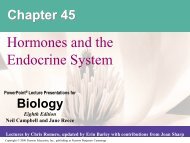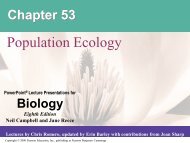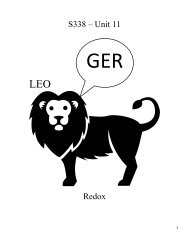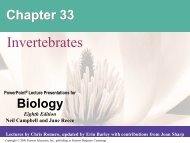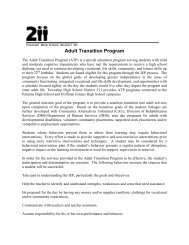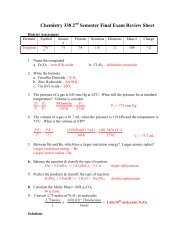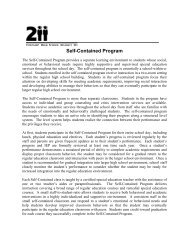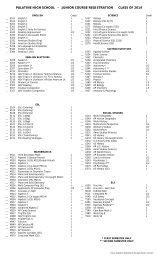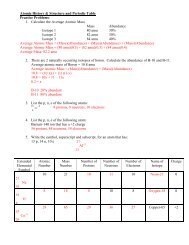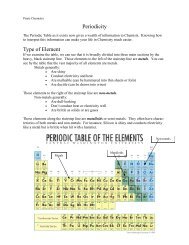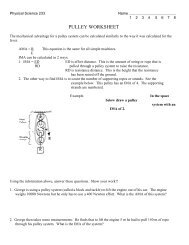Ch 31 PPT
Ch 31 PPT
Ch 31 PPT
Create successful ePaper yourself
Turn your PDF publications into a flip-book with our unique Google optimized e-Paper software.
<strong>Ch</strong>apter <strong>31</strong><br />
Fungi<br />
PowerPoint ® Lecture Presentations for<br />
Biology<br />
Eighth Edition<br />
Neil Campbell and Jane Reece<br />
Lectures by <strong>Ch</strong>ris Romero, updated by Erin Barley with contributions from Joan Sharp<br />
Copyright © 2008 Pearson Education, Inc., publishing as Pearson Benjamin Cummings
Overview: Mighty Mushrooms<br />
• Fungi are diverse and widespread<br />
• They are essential for the well-being of most<br />
terrestrial ecosystems because they break<br />
down organic material and recycle vital<br />
nutrients<br />
Copyright © 2008 Pearson Education, Inc., publishing as Pearson Benjamin Cummings
Fig. <strong>31</strong>-1
Concept <strong>31</strong>.1: Fungi are heterotrophs that feed by<br />
absorption<br />
• Despite their diversity, fungi share key traits,<br />
most importantly the way in which they derive<br />
nutrition<br />
Copyright © 2008 Pearson Education, Inc., publishing as Pearson Benjamin Cummings
Nutrition and Ecology<br />
• Fungi are heterotrophs and absorb nutrients<br />
from outside of their body<br />
• Fungi use enzymes to break down a large<br />
variety of complex molecules into smaller<br />
organic compounds<br />
• The versatility of these enzymes contributes to<br />
fungi’s ecological success<br />
Copyright © 2008 Pearson Education, Inc., publishing as Pearson Benjamin Cummings
• Fungi exhibit diverse lifestyles:<br />
– Decomposers<br />
– Parasites<br />
– Mutualists<br />
Copyright © 2008 Pearson Education, Inc., publishing as Pearson Benjamin Cummings
Body Structure<br />
• The most common body structures are<br />
multicellular filaments and single cells (yeasts)<br />
• Some species grow as either filaments or<br />
yeasts; others grow as both<br />
Animation: Fungal Reproduction and Nutrition<br />
Copyright © 2008 Pearson Education, Inc., publishing as Pearson Benjamin Cummings
Fungal Morphology<br />
• The morphology of multicellular fungi enhances<br />
their ability to absorb nutrients<br />
• Fungi consist of mycelia, networks of<br />
branched hyphae adapted for absorption<br />
• Most fungi have cell walls made of chitin<br />
Copyright © 2008 Pearson Education, Inc., publishing as Pearson Benjamin Cummings
Fig. <strong>31</strong>-2<br />
Reproductive structure<br />
Hyphae<br />
Spore-producing<br />
structures<br />
20 µm<br />
Mycelium
• Some fungi have hyphae divided into cells by<br />
septa, with pores allowing cell-to-cell<br />
movement of organelles<br />
• Coenocytic fungi lack septa<br />
Copyright © 2008 Pearson Education, Inc., publishing as Pearson Benjamin Cummings
Fig. <strong>31</strong>-3<br />
Nuclei<br />
Cell wall<br />
Cell wall<br />
Pore<br />
Septum<br />
Nuclei<br />
(a) Septate hypha<br />
(b) Coenocytic hypha
Specialized Hyphae in Mycorrhizal Fungi<br />
• Some unique fungi have specialized hyphae<br />
called haustoria that allow them to penetrate<br />
the tissues of their host<br />
Copyright © 2008 Pearson Education, Inc., publishing as Pearson Benjamin Cummings
Fig. <strong>31</strong>-4<br />
Nematode<br />
Hyphae<br />
25 µm<br />
(a) Hyphae adapted for trapping and killing prey<br />
Fungal hypha<br />
Plant<br />
cell<br />
wall<br />
Plant cell<br />
(b) Haustoria<br />
Haustorium<br />
Plant cell<br />
plasma<br />
membrane
Fig. <strong>31</strong>-4a<br />
Nematode<br />
Hyphae<br />
25 µm<br />
(a) Hyphae adapted for trapping and killing prey
Fig. <strong>31</strong>-4b<br />
Fungal hypha<br />
Plant<br />
cell<br />
wall<br />
Plant cell<br />
(b) Haustoria<br />
Haustorium<br />
Plant cell<br />
plasma<br />
membrane
• Mycorrhizae are mutually beneficial<br />
relationships between fungi and plant roots<br />
• Ectomycorrhizal fungi form sheaths of<br />
hyphae over a root and also grow into the<br />
extracellular spaces of the root cortex<br />
• Arbuscular mycorrhizal fungi extend hyphae<br />
through the cell walls of root cells and into<br />
tubes formed by invagination of the root cell<br />
membrane<br />
Copyright © 2008 Pearson Education, Inc., publishing as Pearson Benjamin Cummings
Concept <strong>31</strong>.2: Fungi produce spores through<br />
sexual or asexual life cycles<br />
• Fungi propagate themselves by producing vast<br />
numbers of spores, either sexually or asexually<br />
• Fungi can produce spores from different types<br />
of life cycles<br />
Copyright © 2008 Pearson Education, Inc., publishing as Pearson Benjamin Cummings
Fig. <strong>31</strong>-5-1<br />
Key<br />
Haploid (n)<br />
Heterokaryotic<br />
(unfused nuclei from<br />
different parents)<br />
Diploid (2n)<br />
Spore-producing<br />
structures<br />
Spores<br />
ASEXUAL<br />
REPRODUCTION<br />
Mycelium<br />
GERMINATION
Fig. <strong>31</strong>-5-2<br />
Key<br />
Haploid (n)<br />
Heterokaryotic<br />
(unfused nuclei from<br />
different parents)<br />
Diploid (2n)<br />
Spores<br />
Spore-producing<br />
structures<br />
ASEXUAL<br />
REPRODUCTION<br />
PLASMOGAMY<br />
(fusion of cytoplasm)<br />
Mycelium<br />
Heterokaryotic<br />
stage<br />
KARYOGAMY<br />
(fusion of nuclei)<br />
Zygote<br />
SEXUAL<br />
REPRODUCTION<br />
GERMINATION
Fig. <strong>31</strong>-5-3<br />
Key<br />
Haploid (n)<br />
Heterokaryotic<br />
(unfused nuclei from<br />
different parents)<br />
Diploid (2n)<br />
Spores<br />
Spore-producing<br />
structures<br />
ASEXUAL<br />
REPRODUCTION<br />
PLASMOGAMY<br />
(fusion of cytoplasm)<br />
Mycelium<br />
Heterokaryotic<br />
stage<br />
KARYOGAMY<br />
(fusion of nuclei)<br />
Zygote<br />
SEXUAL<br />
REPRODUCTION<br />
GERMINATION<br />
GERMINATION<br />
MEIOSIS<br />
Spores
Sexual Reproduction<br />
• Fungal nuclei are normally haploid, with the<br />
exception of transient diploid stages formed<br />
during the sexual life cycles<br />
• Sexual reproduction requires the fusion of<br />
hyphae from different mating types<br />
• Fungi use sexual signaling molecules called<br />
pheromones to communicate their mating type<br />
Copyright © 2008 Pearson Education, Inc., publishing as Pearson Benjamin Cummings
• Plasmogamy is the union of two parent<br />
mycelia<br />
• In most fungi, the haploid nuclei from each<br />
parent do not fuse right away; they coexist in<br />
the mycelium, called a heterokaryon<br />
• In some fungi, the haploid nuclei pair off two to<br />
a cell; such a mycelium is said to be dikaryotic<br />
Copyright © 2008 Pearson Education, Inc., publishing as Pearson Benjamin Cummings
• Hours, days, or even centuries may pass<br />
before the occurrence of karyogamy, nuclear<br />
fusion<br />
• During karyogamy, the haploid nuclei fuse,<br />
producing diploid cells<br />
• The diploid phase is short-lived and undergoes<br />
meiosis, producing haploid spores<br />
Copyright © 2008 Pearson Education, Inc., publishing as Pearson Benjamin Cummings
Asexual Reproduction<br />
• In addition to sexual reproduction, many fungi<br />
can reproduce asexually<br />
• Molds produce haploid spores by mitosis and<br />
form visible mycelia<br />
Copyright © 2008 Pearson Education, Inc., publishing as Pearson Benjamin Cummings
Fig. <strong>31</strong>-6<br />
2.5 µm
• Other fungi that can reproduce asexually are<br />
yeasts, which inhabit moist environments<br />
• Instead of producing spores, yeasts reproduce<br />
asexually by simple cell division and the<br />
pinching of “bud cells” from a parent cell<br />
Copyright © 2008 Pearson Education, Inc., publishing as Pearson Benjamin Cummings
Fig. <strong>31</strong>-7<br />
10 µm<br />
Parent<br />
cell<br />
Bud
• Many molds and yeasts have no known sexual<br />
stage<br />
• Mycologists have traditionally called these<br />
deuteromycetes, or imperfect fungi<br />
Copyright © 2008 Pearson Education, Inc., publishing as Pearson Benjamin Cummings
Concept <strong>31</strong>.3: The ancestor of fungi was an<br />
aquatic, single-celled, flagellated protist<br />
• Fungi and animals are more closely related to<br />
each other than they are to plants or other<br />
eukaryotes<br />
Copyright © 2008 Pearson Education, Inc., publishing as Pearson Benjamin Cummings
The Origin of Fungi<br />
• Fungi, animals, and their protistan relatives<br />
form the opisthokonts clade<br />
Copyright © 2008 Pearson Education, Inc., publishing as Pearson Benjamin Cummings
Fig. <strong>31</strong>-8<br />
UNICELLULAR,<br />
FLAGELLATED<br />
ANCESTOR<br />
Animals (and their close<br />
protistan relatives)<br />
Nucleariids<br />
<strong>Ch</strong>ytrids<br />
Opisthokonts<br />
Other fungi
• DNA evidence suggests that fungi are most<br />
closely related to unicellular nucleariids while<br />
animals are most closely related to unicellular<br />
choanoflagellates<br />
• This suggests that fungi and animals evolved<br />
from a common flagellated unicellular ancestor<br />
and multicellularity arose separately in the two<br />
groups<br />
• The oldest undisputed fossils of fungi are only<br />
about 460 million years old<br />
Copyright © 2008 Pearson Education, Inc., publishing as Pearson Benjamin Cummings
Fig. <strong>31</strong>-9<br />
50 µm
Are Microsporidia Closely Related to Fungi?<br />
• Microsporidia are unicellular parasites of<br />
animals and protists<br />
• They have tiny organelles derived from<br />
mitochondria but not conventional mitochondria<br />
• Molecular comparisons indicate they may be<br />
closely related to fungi<br />
Copyright © 2008 Pearson Education, Inc., publishing as Pearson Benjamin Cummings
Fig. <strong>31</strong>-10<br />
Host cell<br />
nucleus<br />
Developing<br />
microsporidian<br />
Spore
The Move to Land<br />
• Fungi were among the earliest colonizers of<br />
land and probably formed mutualistic<br />
relationships with early land plants<br />
Copyright © 2008 Pearson Education, Inc., publishing as Pearson Benjamin Cummings
Concept <strong>31</strong>.4: Fungi have radiated into a diverse<br />
set of lineages<br />
• Molecular analyses have helped clarify<br />
evolutionary relationships among fungal<br />
groups, although areas of uncertainty remain<br />
Copyright © 2008 Pearson Education, Inc., publishing as Pearson Benjamin Cummings
Fig. <strong>31</strong>-11<br />
Hyphae 25 µm<br />
<strong>Ch</strong>ytrids (1,000 species)<br />
Zygomycetes (1,000 species)<br />
Fungal hypha<br />
Glomeromycetes (160 species)<br />
Ascomycetes (65,000 species)<br />
Basidiomycetes (30,000 species)
Fig. <strong>31</strong>-11a<br />
Hyphae 25 µm<br />
<strong>Ch</strong>ytrids (1,000 species)
Fig. <strong>31</strong>-11b<br />
Zygomycetes (1,000 species)
Fig. <strong>31</strong>-11c<br />
Fungal hypha<br />
Glomeromycetes (160 species)
Fig. <strong>31</strong>-11d<br />
Ascomycetes (65,000 species)
Fig. <strong>31</strong>-11e<br />
Basidiomycetes (30,000 species)
<strong>Ch</strong>ytrids<br />
• <strong>Ch</strong>ytrids (phylum <strong>Ch</strong>ytridiomycota) are found<br />
in freshwater and terrestrial habitats<br />
• They can be decomposers, parasites, or<br />
mutualists<br />
• Molecular evidence supports the hypothesis<br />
that chytrids diverged early in fungal evolution<br />
• <strong>Ch</strong>ytrids are unique among fungi in having<br />
flagellated spores, called zoospores<br />
Video: Allomyces Zoospore Release<br />
Video: Phlyctochytrium Zoospore Release<br />
Copyright © 2008 Pearson Education, Inc., publishing as Pearson Benjamin Cummings
Fig. <strong>31</strong>-UN1<br />
<strong>Ch</strong>ytrids<br />
Zygomycetes<br />
Glomeromycetes<br />
Ascomycetes<br />
Basidiomycetes
Fig. <strong>31</strong>-12<br />
Flagellum<br />
4 µm
• Until recently, systematists thought that fungi<br />
lost flagella only once in their evolutionary<br />
history<br />
• Molecular data indicate that some “chytrids”<br />
are actually more closely related to another<br />
fungal group, the zygomycetes; chytrids are a<br />
paraphyletic group<br />
Copyright © 2008 Pearson Education, Inc., publishing as Pearson Benjamin Cummings
Zygomycetes<br />
• The zygomycetes (phylum Zygomycota)<br />
exhibit great diversity of life histories<br />
• They include fast-growing molds, parasites,<br />
and commensal symbionts<br />
• The zygomycetes are named for their sexually<br />
produced zygosporangia<br />
• Zygosporangia, which are resistant to freezing<br />
and drying, can survive unfavorable conditions<br />
Copyright © 2008 Pearson Education, Inc., publishing as Pearson Benjamin Cummings
Fig. <strong>31</strong>-UN2<br />
<strong>Ch</strong>ytrids<br />
Zygomycetes<br />
Glomeromycetes<br />
Ascomycetes<br />
Basidiomycetes
• The life cycle of black bread mold (Rhizopus<br />
stolonifer) is fairly typical of the phylum<br />
Copyright © 2008 Pearson Education, Inc., publishing as Pearson Benjamin Cummings
Fig. <strong>31</strong>-13-1<br />
Key<br />
Haploid (n)<br />
Heterokaryotic (n + n)<br />
Diploid (2n)<br />
Rhizopus<br />
growing<br />
on bread<br />
Mating<br />
type (+)<br />
Mating<br />
type (–)<br />
Gametangia with<br />
haploid nuclei<br />
SEXUAL<br />
REPRODUCTION<br />
PLASMOGAMY<br />
Young<br />
zygosporangium<br />
(heterokaryotic)
Fig. <strong>31</strong>-13-2<br />
Key<br />
Haploid (n)<br />
Heterokaryotic (n + n)<br />
Diploid (2n)<br />
PLASMOGAMY<br />
Rhizopus<br />
growing<br />
on bread<br />
Mating<br />
type (+)<br />
Mating<br />
type (–)<br />
Gametangia with<br />
haploid nuclei<br />
SEXUAL<br />
REPRODUCTION<br />
Young<br />
zygosporangium<br />
(heterokaryotic)<br />
100 µm<br />
Zygosporangium<br />
KARYOGAMY<br />
Diploid<br />
nuclei
Fig. <strong>31</strong>-13-3<br />
Key<br />
Haploid (n)<br />
Heterokaryotic (n + n)<br />
Diploid (2n)<br />
PLASMOGAMY<br />
Rhizopus<br />
growing<br />
on bread<br />
Mating<br />
type (+)<br />
Mating<br />
type (–)<br />
Gametangia with<br />
haploid nuclei<br />
SEXUAL<br />
REPRODUCTION<br />
Young<br />
zygosporangium<br />
(heterokaryotic)<br />
100 µm<br />
Dispersal and<br />
germination<br />
Spores<br />
Sporangium<br />
MEIOSIS<br />
KARYOGAMY<br />
Diploid<br />
nuclei<br />
Zygosporangium
Fig. <strong>31</strong>-13-4<br />
Key<br />
Haploid (n)<br />
Heterokaryotic (n + n)<br />
Diploid (2n)<br />
PLASMOGAMY<br />
Rhizopus<br />
growing<br />
on bread<br />
Mating<br />
type (+)<br />
Mating<br />
type (–)<br />
Gametangia with<br />
haploid nuclei<br />
SEXUAL<br />
REPRODUCTION<br />
Young<br />
zygosporangium<br />
(heterokaryotic)<br />
100 µm<br />
Sporangia<br />
Dispersal and<br />
germination<br />
KARYOGAMY<br />
Zygosporangium<br />
Spores<br />
ASEXUAL<br />
REPRODUCTION<br />
Sporangium<br />
MEIOSIS<br />
Diploid<br />
nuclei<br />
Dispersal and<br />
germination<br />
50 µm<br />
Mycelium
• Some zygomycetes, such as Pilobolus, can<br />
actually “aim” their sporangia toward conditions<br />
associated with good food sources<br />
Copyright © 2008 Pearson Education, Inc., publishing as Pearson Benjamin Cummings
Fig. <strong>31</strong>-14<br />
0.5 mm
Glomeromycetes<br />
• The glomeromycetes (phylum<br />
Glomeromycota) were once considered<br />
zygomycetes<br />
• They are now classified in a separate clade<br />
• Glomeromycetes form arbuscular mycorrhizae<br />
Copyright © 2008 Pearson Education, Inc., publishing as Pearson Benjamin Cummings
Fig. <strong>31</strong>-UN3<br />
<strong>Ch</strong>ytrids<br />
Zygomycetes<br />
Glomeromycetes<br />
Ascomycetes<br />
Basidiomycetes
Fig. <strong>31</strong>-15<br />
2.5 µm
Ascomycetes<br />
• Ascomycetes (phylum Ascomycota) live in<br />
marine, freshwater, and terrestrial habitats<br />
• The phylum is defined by production of sexual<br />
spores in saclike asci, usually contained in<br />
fruiting bodies called ascocarps<br />
• Ascomycetes are commonly called sac fungi<br />
• Ascomycetes vary in size and complexity from<br />
unicellular yeasts to elaborate cup fungi and<br />
morels<br />
Copyright © 2008 Pearson Education, Inc., publishing as Pearson Benjamin Cummings
Fig. <strong>31</strong>-UN4<br />
<strong>Ch</strong>ytrids<br />
Zygomycetes<br />
Glomeromycetes<br />
Ascomycetes<br />
Basidiomycetes
Fig. <strong>31</strong>-16<br />
Morchella esculenta,<br />
the tasty morel<br />
Tuber melanosporum, a truffle
Fig. <strong>31</strong>-16a<br />
Morchella esculenta,<br />
the tasty morel
Fig. <strong>31</strong>-16b<br />
Tuber melanosporum, a truffle
• Ascomycetes include plant pathogens,<br />
decomposers, and symbionts<br />
• Ascomycetes reproduce asexually by<br />
enormous numbers of asexual spores called<br />
conidia<br />
• Conidia are not formed inside sporangia; they<br />
are produced asexually at the tips of<br />
specialized hyphae called conidiophores<br />
• Neurospora is a model organism with a wellstudied<br />
genome<br />
Copyright © 2008 Pearson Education, Inc., publishing as Pearson Benjamin Cummings
Fig. <strong>31</strong>-17-1<br />
Haploid spores (conidia)<br />
Dispersal<br />
ASEXUAL<br />
REPRODUCTION<br />
Germination<br />
Hypha<br />
Key<br />
Haploid (n)<br />
Dikaryotic (n + n)<br />
Diploid (2n)<br />
Conidiophore<br />
Mycelium
Fig. <strong>31</strong>-17-2<br />
Haploid spores (conidia)<br />
Conidiophore<br />
Dispersal<br />
ASEXUAL<br />
REPRODUCTION<br />
Germination<br />
Hypha<br />
Conidia;<br />
mating type (–)<br />
Mating<br />
type (+)<br />
PLASMOGAMY<br />
Key<br />
Haploid (n)<br />
Dikaryotic (n + n)<br />
Diploid (2n)<br />
Ascus<br />
(dikaryotic)<br />
Mycelium<br />
Mycelia<br />
Dikaryotic<br />
hyphae<br />
SEXUAL<br />
REPRODUCTION
Fig. <strong>31</strong>-17-3<br />
Haploid spores (conidia)<br />
Conidiophore<br />
Dispersal<br />
ASEXUAL<br />
REPRODUCTION<br />
Germination<br />
Hypha<br />
Conidia;<br />
mating type (–)<br />
Mating<br />
type (+)<br />
PLASMOGAMY<br />
Key<br />
Haploid (n)<br />
Dikaryotic (n + n)<br />
Diploid (2n)<br />
Ascus<br />
(dikaryotic)<br />
Mycelium<br />
Mycelia<br />
Dikaryotic<br />
hyphae<br />
SEXUAL<br />
REPRODUCTION<br />
KARYOGAMY<br />
Diploid nucleus<br />
(zygote)
Fig. <strong>31</strong>-17-4<br />
Haploid spores (conidia)<br />
Conidiophore<br />
Dispersal<br />
ASEXUAL<br />
REPRODUCTION<br />
Germination<br />
Hypha<br />
Conidia;<br />
mating type (–)<br />
Mating<br />
type (+)<br />
PLASMOGAMY<br />
Key<br />
Haploid (n)<br />
Dikaryotic (n + n)<br />
Diploid (2n)<br />
Ascus<br />
(dikaryotic)<br />
Mycelium<br />
Germination<br />
Ascocarp<br />
Mycelia<br />
Dispersal<br />
Asci<br />
Dikaryotic<br />
hyphae<br />
SEXUAL<br />
REPRODUCTION<br />
Eight<br />
ascospores<br />
KARYOGAMY<br />
Diploid nucleus<br />
(zygote)<br />
Four<br />
haploid<br />
nuclei<br />
MEIOSIS
Basidiomycetes<br />
• Basidomycetes (phylum Basidiomycota)<br />
include mushrooms, puffballs, and shelf fungi,<br />
mutualists, and plant parasites<br />
• The phylum is defined by a clublike structure<br />
called a basidium, a transient diploid stage in<br />
the life cycle<br />
• The basidiomycetes are also called club fungi<br />
Copyright © 2008 Pearson Education, Inc., publishing as Pearson Benjamin Cummings
Fig. <strong>31</strong>-UN5<br />
<strong>Ch</strong>ytrids<br />
Zygomycetes<br />
Glomeromycetes<br />
Ascomycetes<br />
Basidiomycetes
Fig. <strong>31</strong>-18<br />
Maiden veil fungus<br />
(Dictyphora), a<br />
fungus with an<br />
odor like rotting<br />
meat<br />
Puffballs emitting<br />
spores<br />
Shelf fungi, important<br />
decomposers of wood
Fig. <strong>31</strong>-18a<br />
Maiden veil fungus<br />
(Dictyphora), a<br />
fungus with an odor<br />
like rotting meat
Fig. <strong>31</strong>-18b<br />
Puffballs emitting<br />
spores
Fig. <strong>31</strong>-18c<br />
Shelf fungi, important<br />
decomposers of wood
• The life cycle of a basidiomycete usually<br />
includes a long-lived dikaryotic mycelium<br />
• In response to environmental stimuli, the<br />
mycelium reproduces sexually by producing<br />
elaborate fruiting bodies call basidiocarps<br />
• Mushrooms are examples of basidiocarps<br />
• The numerous basidia in a basidiocarp are<br />
sources of sexual spores called basidiospores<br />
Copyright © 2008 Pearson Education, Inc., publishing as Pearson Benjamin Cummings
Fig. <strong>31</strong>-19-1<br />
Haploid mycelia<br />
PLASMOGAMY<br />
Dikaryotic mycelium<br />
Mating<br />
type (–)<br />
Mating<br />
type (+)<br />
SEXUAL<br />
REPRODUCTION<br />
Key<br />
Haploid (n)<br />
Dikaryotic (n+n)<br />
Diploid (2n)
Fig. <strong>31</strong>-19-2<br />
Haploid mycelia<br />
PLASMOGAMY<br />
Dikaryotic mycelium<br />
Mating<br />
type (–)<br />
Mating<br />
type (+)<br />
Gills lined<br />
with basidia<br />
SEXUAL<br />
REPRODUCTION<br />
Basidiocarp<br />
(n+n)<br />
Basidia<br />
(n+n)<br />
Key<br />
Haploid (n)<br />
Dikaryotic (n+n)<br />
Diploid (2n)
Fig. <strong>31</strong>-19-3<br />
Haploid mycelia<br />
PLASMOGAMY<br />
Dikaryotic mycelium<br />
Mating<br />
type (–)<br />
Mating<br />
type (+)<br />
Gills lined<br />
with basidia<br />
SEXUAL<br />
REPRODUCTION<br />
Basidiocarp<br />
(n+n)<br />
Basidia<br />
(n+n)<br />
KARYOGAMY<br />
Diploid<br />
nuclei<br />
Key<br />
Haploid (n)<br />
Dikaryotic (n+n)<br />
Diploid (2n)
Fig. <strong>31</strong>-19-4<br />
Haploid mycelia<br />
PLASMOGAMY<br />
Dikaryotic mycelium<br />
Mating<br />
type (–)<br />
Haploid<br />
mycelia<br />
Mating<br />
type (+)<br />
SEXUAL<br />
REPRODUCTION<br />
Gills lined<br />
with basidia<br />
Basidiocarp<br />
(n+n)<br />
Basidium<br />
Dispersal and<br />
germination<br />
Basidiospores<br />
(n)<br />
Basidium with<br />
four basidiospores<br />
Basidium containing<br />
four haploid nuclei<br />
MEIOSIS<br />
Basidia<br />
(n+n)<br />
KARYOGAMY<br />
Key<br />
1 µm<br />
Basidiospore<br />
Diploid<br />
nuclei<br />
Haploid (n)<br />
Dikaryotic (n+n)<br />
Diploid (2n)
Fig. <strong>31</strong>-20
Concept <strong>31</strong>.5: Fungi play key roles in nutrient<br />
cycling, ecological interactions, and human welfare<br />
• Fungi interact with other organisms in many<br />
ways<br />
Copyright © 2008 Pearson Education, Inc., publishing as Pearson Benjamin Cummings
Fungi as Decomposers<br />
• Fungi are efficient decomposers<br />
• They perform essential recycling of chemical<br />
elements between the living and nonliving<br />
world<br />
Copyright © 2008 Pearson Education, Inc., publishing as Pearson Benjamin Cummings
Fungi as Mutualists<br />
• Fungi form mutualistic relationships with plants,<br />
algae, cyanobacteria, and animals<br />
• All of these relationships have profound<br />
ecological effects<br />
Copyright © 2008 Pearson Education, Inc., publishing as Pearson Benjamin Cummings
Fungus-Plant Mutualisms<br />
• Mycorrhizae are enormously important in<br />
natural ecosystems and agriculture<br />
• Plants harbor harmless symbiotic endophytes<br />
that live inside leaves or other plant parts<br />
• Endophytes make toxins that deter herbivores<br />
and defend against pathogens<br />
Copyright © 2008 Pearson Education, Inc., publishing as Pearson Benjamin Cummings
Fig. <strong>31</strong>-21<br />
RESULTS<br />
Endophyte not present; pathogen present (E–P+)<br />
Both endophyte and pathogen present (E+P+)<br />
Leaf mortality (%)<br />
30<br />
20<br />
10<br />
0<br />
E–P+<br />
E+P+<br />
Leaf area damaged (%)<br />
15<br />
10<br />
5<br />
0<br />
E–P+<br />
E+P+
Fungus-Animal Symbioses<br />
• Some fungi share their digestive services with<br />
animals<br />
• These fungi help break down plant material in<br />
the guts of cows and other grazing mammals<br />
• Many species of ants and termites use the<br />
digestive power of fungi by raising them in<br />
“farms”<br />
Copyright © 2008 Pearson Education, Inc., publishing as Pearson Benjamin Cummings
Fig. <strong>31</strong>-22
Lichens<br />
• A lichen is a symbiotic association between a<br />
photosynthetic microorganism and a fungus in<br />
which millions of photosynthetic cells are held<br />
in a mass of fungal hyphae<br />
Copyright © 2008 Pearson Education, Inc., publishing as Pearson Benjamin Cummings
Fig. <strong>31</strong>-23<br />
A fruticose (shrublike) lichen<br />
Crustose<br />
(encrusting)<br />
lichens<br />
A foliose<br />
(leaflike)<br />
lichen
Fig. <strong>31</strong>-23a<br />
A fruticose (shrublike) lichen
Fig. <strong>31</strong>-23b<br />
Crustose<br />
(encrusting)<br />
lichens
Fig. <strong>31</strong>-23c<br />
A foliose<br />
(leaflike)<br />
lichen
• The fungal component of a lichen is most often<br />
an ascomycete<br />
• Algae or cyanobacteria occupy an inner layer<br />
below the lichen surface<br />
Copyright © 2008 Pearson Education, Inc., publishing as Pearson Benjamin Cummings
Fig. <strong>31</strong>-24<br />
Ascocarp of fungus<br />
Fungal<br />
hyphae<br />
Algal<br />
layer<br />
Soredia<br />
Algal cell<br />
Fungal hyphae
• The algae provide carbon compounds,<br />
cyanobacteria provide organic nitrogen, and<br />
fungi provide the environment for growth<br />
• The fungi of lichens can reproduce sexually<br />
and asexually<br />
• Asexual reproduction is by fragmentation or the<br />
formation of soredia, small clusters of hyphae<br />
with embedded algae<br />
Copyright © 2008 Pearson Education, Inc., publishing as Pearson Benjamin Cummings
• Lichens are important pioneers on new rock<br />
and soil surfaces<br />
• Lichens are sensitive to pollution, and their<br />
death can be a warning that air quality is<br />
deteriorating<br />
Copyright © 2008 Pearson Education, Inc., publishing as Pearson Benjamin Cummings
Fungi as Pathogens<br />
• About 30% of known fungal species are<br />
parasites or pathogens, mostly on or in plants<br />
• Some fungi that attack food crops are toxic to<br />
humans<br />
• Animals are much less susceptible to parasitic<br />
fungi than are plants<br />
• The general term for a fungal infection in<br />
animals is mycosis<br />
Copyright © 2008 Pearson Education, Inc., publishing as Pearson Benjamin Cummings
Fig. <strong>31</strong>-25<br />
(a) Corn smut on corn<br />
(b) Tar spot fungus on<br />
maple leaves<br />
(c) Ergots on rye
Fig. <strong>31</strong>-25a<br />
(a) Corn smut on corn
Fig. <strong>31</strong>-25b<br />
(b) Tar spot fungus on<br />
maple leaves
Fig. <strong>31</strong>-25c<br />
(c) Ergots on rye
Practical Uses of Fungi<br />
• Humans eat many fungi and use others to<br />
make cheeses, alcoholic beverages, and bread<br />
• Some fungi are used to produce antibiotics for<br />
the treatment of bacterial infections, for<br />
example the ascomycete Penicillium<br />
• Genetic research on fungi is leading to<br />
applications in biotechnology<br />
– For example, insulin-like growth factor can be<br />
produced in the fungus Saccharomyces<br />
cerevisiae<br />
Copyright © 2008 Pearson Education, Inc., publishing as Pearson Benjamin Cummings
Fig. <strong>31</strong>-26<br />
Staphylococcus<br />
Penicillium<br />
Zone of<br />
inhibited<br />
growth
Fig. <strong>31</strong>-UN6
Fig. <strong>31</strong>-UN6a
Fig. <strong>31</strong>-UN6b
Fig. <strong>31</strong>-UN6c
Fig. <strong>31</strong>-UN6d
Fig. <strong>31</strong>-UN6e
Fig. <strong>31</strong>-T1
Fig. <strong>31</strong>-UN7
You should now be able to:<br />
1. List the characteristics that distinguish fungi<br />
from other multicellular kingdoms<br />
2. Distinguish between ectomycorrhizal and<br />
arbuscular mycorrhizal fungi<br />
3. Describe the processes of plasmogamy and<br />
karyogamy<br />
4. Describe the evidence that multicellularity<br />
evolved independently in fungi and animals<br />
Copyright © 2008 Pearson Education, Inc., publishing as Pearson Benjamin Cummings
5. Describe the life cycles of Rhizopus stolonifer<br />
and Neurospora crassa<br />
6. Distinguish among zygomycetes,<br />
ascomycetes, and basidiomycetes<br />
7. Describe some of the roles of fungi in<br />
ecosystems, lichens, animal-fungi mutualistic<br />
symbioses, food production, and medicine and<br />
as pathogens<br />
Copyright © 2008 Pearson Education, Inc., publishing as Pearson Benjamin Cummings




